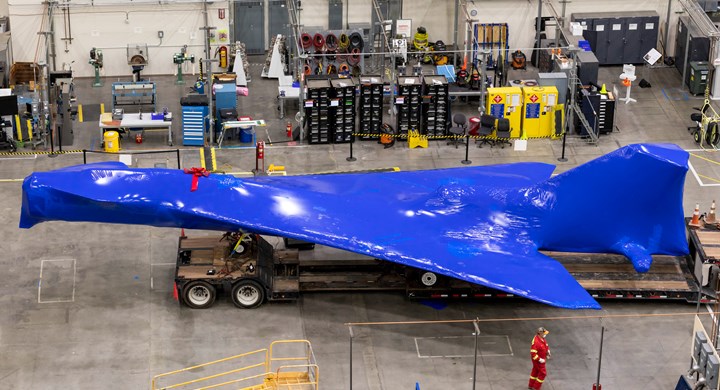Quiet supersonic demonstrator X-59 begins ground testing in Texas
Critical testing ensure the composite aircraft can withstand the loads and stresses that typically occur during supersonic flight.

NASA’s X-59 Quiet SuperSonic Technology aircraft (QueSST) is pictured here at Lockheed Martin Skunk Works in California, wrapped up in preparation for its move to Texas. Photo Credit: Lockheed Martin.
With significant milestones achieved in the assembly of NASA’s composites-intensive X-59 Quiet SuperSonic Technology aircraft (QueSST) in 2021, all eyes now look forward to a pivotal 2022. Following the X-plane’s temporary move from Lockheed Martin’s Skunk Works facility in Palmdale, Calif., U.S., to its facilities in Texas, the X-59 is set to start the new year with critical ground testing, as progress continues toward NASA’s target of the aircraft’s first flight later this year.
While in Texas, ground testing of the X-59 will ensure the aircraft can withstand the loads and stresses that typically occur during supersonic flight. The team will also calibrate and test the fuel systems before the X-59 makes the journey back to California for more tests and completion.
The X-59 is designed to reduce the loudness of the sonic boom, which occurs when an aircraft flies faster than the speed of sound, to a gentle, quiet sonic “thump.” The X-plane will demonstrate this in flights over communities around the U.S. starting in 2024, as NASA collects data that could open the future to commercial supersonic flights over land (learn more about this effort, “Lockheed Martin prepares X-59 for quiet supersonic flight testing”).
The primary composite component of the X-59 is the single-piece delta wing. Ingersoll’s (Rockford, Ill., U.S.) Mongoose system manufactures the wing skins via automated fiber placement (AFP). Holes for assembly to the fuselage and tail are made using an automated drilling system. Importantly, the aircraft is designed so that the engine and intake/exhaust systems are on top of the aircraft, instead of underneath, effectively muffling the boom that occurs upon reaching supersonic speeds.
Related Content
-
CFRTP upper stage propellant tank
PROCOMP uses in-situ consolidation AFP and ultrasonic welding to demonstrate lightweight, novel tank design.
-
PEEK vs. PEKK vs. PAEK and continuous compression molding
Suppliers of thermoplastics and carbon fiber chime in regarding PEEK vs. PEKK, and now PAEK, as well as in-situ consolidation — the supply chain for thermoplastic tape composites continues to evolve.
-
Plant tour: Joby Aviation, Marina, Calif., U.S.
As the advanced air mobility market begins to take shape, market leader Joby Aviation works to industrialize composites manufacturing for its first-generation, composites-intensive, all-electric air taxi.













